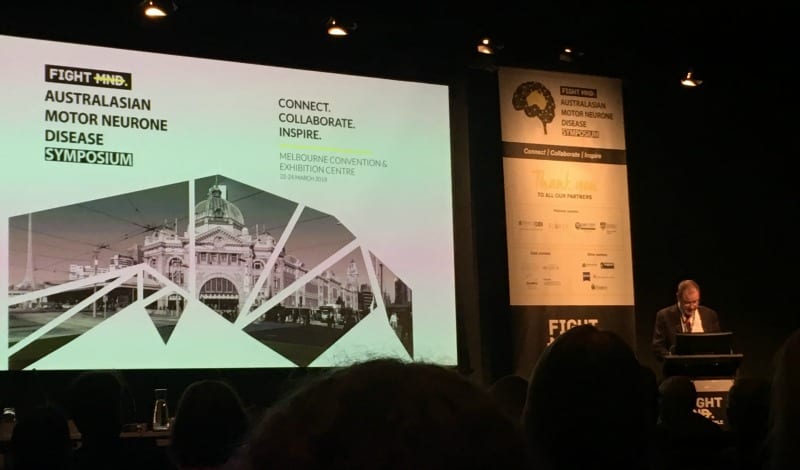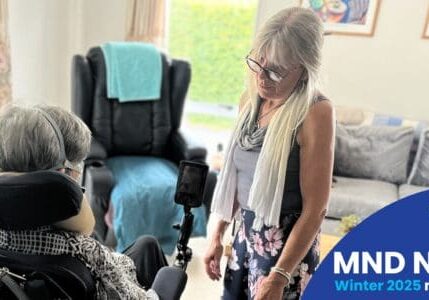Australasian MND Symposium – our final summary
Research
27 September 2018

“It’s a very exciting time to be involved in MND research. There’s a lot of hope and positivity.” – Professor Matthew Kiernan, Bushell Chair of Neurology, Sydney Medical School The first Australasian MND Symposium, held in March 2018, was an in-depth, technical, fascinating glimpse into current MND research from all over the world.
We learned there are more therapeutic approaches being developed for MND than ever before, increasing the likelihood that new therapies will become available that provide a meaningful impact on the lives of people with MND. Several drug development avenues are being explored, and any one could have a big impact.
The current thinking is that, in future, those with familial MND are likely to be treated with DNA therapies such as CRISPR (see page 14) and antisense oligonucleotides (ASOs). Clinical trials have begun this year that use ASOs to treat the two most common genetic forms of MND (SOD1 and C9orf72). Researchers at the Symposium seemed extremely optimistic that successful treatments for these familial forms of MND may be found within the next 5 to 15 years.
Researchers expect sporadic MND to continue to be separated into more specific sub-types, allowing people with sporadic MND to eventually be treated with very personalised medicines (an approach known as ‘precision medicine’).
“I’m really optimistic for the future for the next 5 to 15 years. It will lead to a cure.” – Prof Paul Talman, director, Australian MND Registry
There was a lot of discussion about why clinical trials for MND treatments have not been more successful. Frustratingly, 18 clinical trials have failed in the last decade. Researchers now understand they need to select more homogeneous groups of people for clinical trials, who share similar genetic factors, environmental factors, progression rates and patterns. And researchers are urgently working to identify biomarkers (eg in blood or urine) that reflect the underlying biology of MND, to ensure clinical trials can better measure their effectiveness.
MND is extremely complex but many researchers said they were more optimistic than they’d ever been. There has been an exponential increase in our knowledge of the basic mechanisms of MND, and knowledge Is increasing at an extraordinary rate, especially in the last 2 or 3 years.
Professor Robert Henderson, University of Queensland, simply explained a current theory of the mechanisms of MND: “Whatever causes MND results in misfolded proteins, which triggers an immune response, which causes inflammation, which causes damage to functional cells. This cell stress leads to motor neuron death, which leads to motor function loss.”
Progress is also being made towards finding the cause of MND. We now know of 25 risk genes for MND, each of which increases a person’s risk of developing MND by 5% to 10%. At the current rate of discovery, in four years we will have found 50 risk genes. These genetic discoveries give us a better idea of the pathways that should be targeted by drugs, including common pathways between genetic and sporadic MND.
Developing MND is now thought to be a multistep process where genetic risk and environmental factors accumulate over time until a threshold of disease is reached. Six of these steps are required for MND to develop (fewer for familial MND).
We have an incomplete understanding of these steps and how they cascade, because it’s much harder to identify environmental risk factors than to find genetic risks. Environmental risk factors that many, but not all studies have agreed on are: smoking, trauma (eg broken bone, surgery), diesel fumes, exercise, being a war veteran (see page 16 for New Zealand research).
There was also some valuable research into MND care reported at the symposium.
Multidisciplinary clinics (MDTs) are seen as one of the biggest advances in recent years. Research shows that people receiving coordinated care through MDTs live on average a year longer. “MDT clinics are the biggest advance in the treatment of MND,” said Professor Jeremy Shefner of the Barrow Neurological Institute in the US. “Patients in MDTs live on average a year longer.”
Evidence also suggests that survival and quality of life is improved by early intervention with non-invasive ventilation. There is also increasing evidence that palliative care, when integrated into a multidisciplinary approach to care, leads to improved symptoms and quality of life in people with MND and their families.
For more in-depth information about current research towards a cure and understanding the causes of MND, see Research Resources


